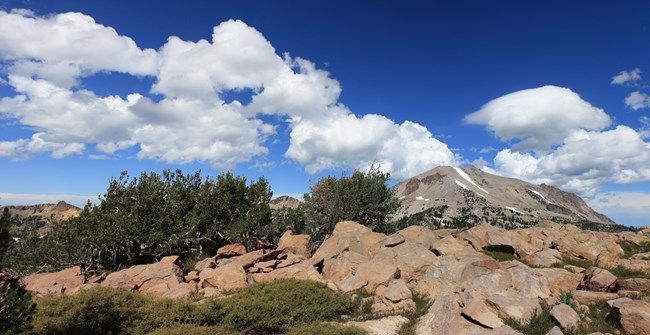
NPS/Steve Buckley
Whitebark pines (Pinus albicaulis) are picturesque, long-lived, and hardy trees that thrive at sites with harsh climates, where few or no other trees survive. Whitebark pine is the dominant timberline tree in subalpine habitats at Crater Lake and Lassen Volcanic National Parks. Their large and nutritious seeds are prized by wildlife including Clark's Nutcrackers, black bears, and ground squirrels. Other wildlife use trees for shelter. Whitebark pine canopies support lichens and other plants. These trees also stabilize soil and regulate snowmelt.
Whitebark pine, however, are declining in the face of multiple threats. As of January 2023, they are now a federally threatened species under the Endangered Species Act. White pine blister rust is a fungal infection caused by the non-native pathogen, Cronartium ribicola; this fungus is killing significant numbers of whitebark pine. Changes resulting from the disease are likely to have profound, ecosystem-wide effects. Mountain pine beetles also cause extensive damage to whitebark pine during beetle outbreaks, and climate change can exacerbate these stressors.
Since 2012, we have monitored whitebark pine and its stressors at Crater Lake and Lassen Volcanic National Parks to determine the current status of this species and long term trends.
Objectives are to:
- Infection and death rates of whitebark pine from blister rust disease, mountain pine beetle, and other agents (fire, native diseases) over time.
- Associated plant species composition
We monitor:
-
Evidence of infection from blister rust and mountain pine beetles
-
Tree and seedling characteristics
Monitoring Documents
Source: NPS DataStore Saved Search 619. To search for additional information, visit the NPS DataStore.
Source: NPS DataStore Saved Search 3344. To search for additional information, visit the NPS DataStore.
Source: NPS DataStore Saved Search 4949. To search for additional information, visit the NPS DataStore.
Articles
Last updated: November 8, 2024
